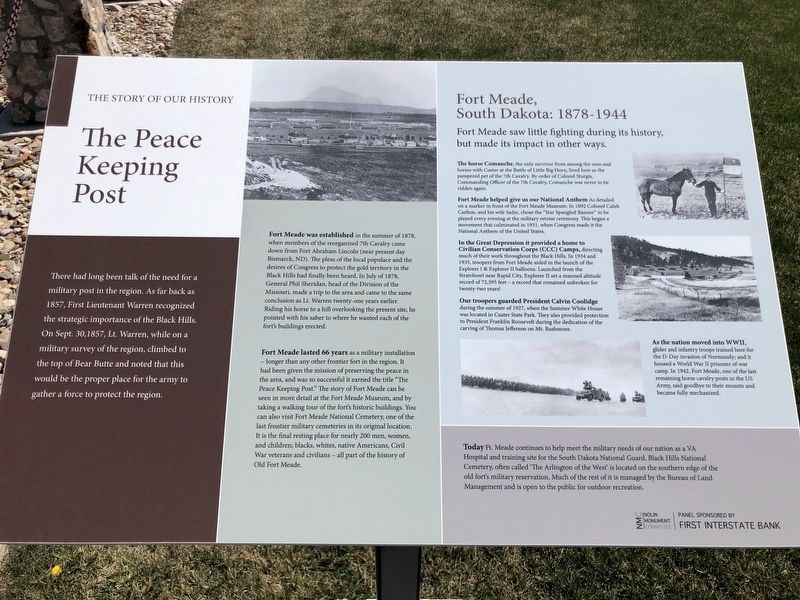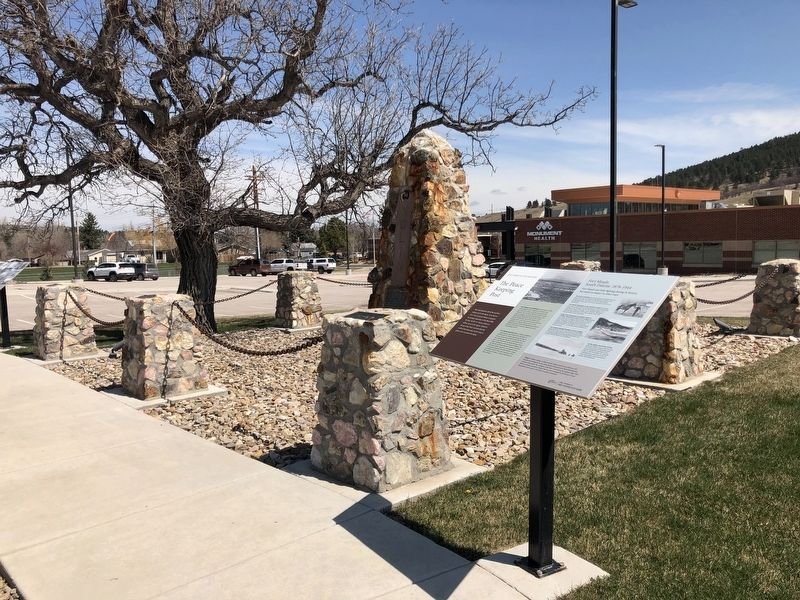Sturgis in Meade County, South Dakota — The American Midwest (Upper Plains)
The Peace Keeping Post
The Story of our History
Fort Meade was established in the summer of 1878, when members of the reorganized 7th Cavalry came down from Fort Abraham Lincoln (near present day Bismarck, ND). The pleas of the local populace and the desires of Congress to protect the gold territory in the Black Hills had finally been heard. In July of 1878, General Phil Sheridan, head of the Division of the Missouri, made a trip to the area and came to the same conclusion as Lt. Warren twenty-one years earlier. Ricing his horse to a hill overlooking the present site, he pointed with his saber to where he wanted each of the fort's buildings erected.
Fort Meade lasted 66 years as a military installation - longer than any other frontier fort in the region. It had been given the mission of preserving the peace in the area, and was so successful it earned the title "The Peace Keeping Post". The story of Fort Meade can be seen in more detail at the Fort Meade Museum, and by taking a walking tour of the fort's historic buildings. You can also visit Fort Meade National Cemetery, one of the last frontier military cemeteries in its original location. It is the final resting place for nearly 200 men, women, and children; blacks, whites, native Americans, Civil War veterans and civilians - all part of the history of Old Fort Meade.
Fort Meade, South Dakota: 1878-1944
Fort Meade saw little fighting during its history, but made its impact in other ways.
The horse Comanche, the only survivor from among the men and horses with Custer at the Battle of Little Big Horn, lived here as the pampered pet of the 7th Cavalry. By order of Colonel Sturgis, Commanding Officer of the 7th Cavalry, Comanche was never to be ridden again.
Fort Meade helped give us our National Anthem As detailed on a marker in front of the Fort Meade Museum: In 1892 Colonel Caleb Carlton, and his wife Sadie, chose the "Star Spangled Banner" to be played every evening at the military retreat ceremony. This began a movement that culminated in 1931, when Congress made it the National Anthem of the United States.
In the Great Depression it provided a home to Civilian Conservation Corps (CCC) Camps, directing much of their work throughout the Black Hills. In 1934 and 1935, troopers from Fort Meade aided in the launch of the Explorer I & Explorer II balloons. Launched from the Stratobowl near Rapid City, Explorer II set a manned altitude record of 72, 395 feet - a record that remained unbroken for twenty-two years!
Our troopers guarded President Calvin Coolidge during the summer of 1927, when the Summer White House was located in Custer State Park. They also provided protection to President Franklin Roosevelt during the dedication of the carving of Thomas Jefferson on Mt. Rushmore.
As the nation moved into WWII. glider and infantry troops trained here for the D-Day invasion of Normandy; and it housed a World War II prisoner of war camp. In 1942, Fort Meade, one of the last remaining horse cavalry posts in the US Army, said goodbye to their mounts and became fully mechanized.
Today Ft. Meade continues to help meet the military needs of our nation as a VA Hospital and training site for the South Dakota National guard. Black Hills National Cemetery, often called 'The Arlington of the West' is located on the southern edge of the old fort's military reservation. Much of the rest of it is managed by the Bureau of Land Management and is open to the public for outdoor recreation.
Erected by Nolin Monument Committee and First Interstate Bank.
Topics. This historical marker is listed in these topic lists: Arts, Letters, Music • Forts and Castles. A significant historical month for this entry is July 1878.
Location. 44° 24.12′ N, 103° 30.538′ W. Marker is in Sturgis, South Dakota, in Meade County. Marker is at the intersection of Junction Ave and Harmon Street on Junction Ave. Located near the Sturgis Regional Hospital. Touch for map. Marker is at or near this postal address: 2140 Junction Avenue, Sturgis SD 57785, United States of America. Touch for directions.
Other nearby markers. At least 8 other markers are within 2 miles of this marker, measured as the crow flies. Born of Opportunity (here, next to this marker); The Fate of the Mail Carrier (a few steps from this marker); Charles Nolin, Pony Mail Carrier (a few steps from this marker); Broken Promises (a few steps from this marker); a different marker also named Charles Nolin (a few steps from this marker); Treaties are formed (a few steps from this marker); a different marker also named Charles Nolin (approx. 0.9 miles away); Civilian Conservation Corps Camps (approx. 1˝ miles away). Touch for a list and map of all markers in Sturgis.
Credits. This page was last revised on May 30, 2021. It was originally submitted on May 28, 2021, by Ruth VanSteenwyk of Aberdeen, South Dakota. This page has been viewed 120 times since then and 10 times this year. Photos: 1, 2. submitted on May 28, 2021, by Ruth VanSteenwyk of Aberdeen, South Dakota. • Mark Hilton was the editor who published this page.

